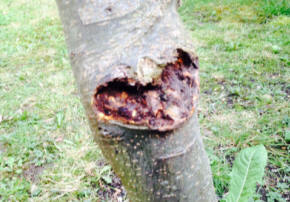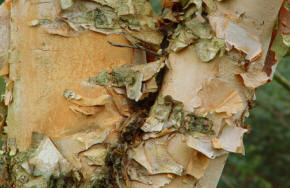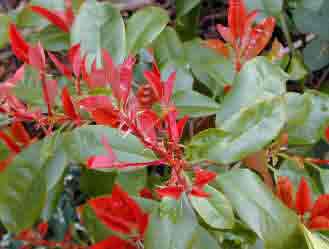Stem Bark Problems on Garden Plants
Problems on bark or inside plant stems can be caused by plant
pests, plant diseases, malnutrition, physical aspects, frost
damage, sun damage and many other things.
Plant stems are a good line of transport for garden pests that want to
travel from leaf to leaf. Often the stem is simply used as a means of
getting from point A to B. But there are a number of problems -
generally associated with pests or diseases - that can cause problems
directly to the plant stem. On the pest side, slugs are quite happy to
chomp away at the more tender stems, whilst some fungal diseases cause
problems with plant stems also. Blackleg fungus is one such disease
which affects plant stems.
In some instances, plants seem to have simply 'collapsed' at or near
ground level. This can be caused either by pests eating at the base of
the stem, or by various fungi that cause problem. Damping off of
seedlings, where many seedlings in a plant tray will simply collapse
because of Pythium of Phytopthora fungal attacks .
On mature plants, there can be many stem problems associated with severe or 'out-of-the-ordinary' weather conditions. This will sometimes be the result of the plant (shrub) being planted in the wrong place. An instance would be a Japanese Maple (with thin bark) being planted in a hot sunny place.


Apple Tree Canker Wound | Betula Bark Natural Peeling | Heavy Scale
insect infection on Apple Tree Stem
Physical damage can result in long splits in the bark of some trees. This is often caused by severe frosting followed by a rapid thawing action. This results in rapid expansion of the plant tissue, which in effect shatters the wood and then manifests itself as split stems.
Stem problems caused by bacterial diseases.
Most of the problems associated with stem damage, are caused by a wide range of bacterial diseases – including fungal attacks. Viruses are rarely a direct problem for stems.
Stem Rots are wide and varied, and can cause problems on a wide range of tender and hardy plants, including hardy woody stemmed plants such as shrubs and trees. Vegetables and fruit are also affected by different stem rots, most of which are only noticed when plant is severely affected.
Stem Cankers and growths such as Galls and Witches Brooms are variable in their severity, with many simply needing to be cut out as a first control measure. Others such as bacterial cankers need a wider range of treatments and measures to prevent.
Bacterial Cankers look different, but can have the same fatal outcome as other cankers.
Coral Spot Disease can affect the branches of several hardy shrubby plants - notably the Acer family.
Dieback Disease - where the tips of stems gradually turn black and then the problem descends further down into the plant stems - is caused by a number of different bacterial/fungal diseases
Dutch Elm Disease kills branches or stems, after being infected by a beetle boring into the bark. The spreading fungus disease feeds just below the bark - the cambium layer - and invades the vascular tissue which transports tbe goodies throughout the tree.
Silver Leaf Disease is the symptom of a fungal disease under the bark of stems.
Fireblight which is noticed in the browning of foliage is a fungal disease spreading through the trunks and eventually preventing circulation within the plant system.
Honey Fungus is far more prevalent than generally accepted, and usually results in the death of the infected shrub or tree.
Wire Stem is rarely diagnosed, but is a disease that can affect young plants and seedlings of the Brassica family. The name is descriptive of the visual appearance.
Grey Mould, a fungal disease, can affect stems as well as foliage and flowers.
Sooty Mould on stems is rarely a problem other than visual. It is the result of a mould feeding on the sweet secretion of a number of different aphids. (It can be a problem on leaves, as it prevents light getting through for the all important photosynthesis action which is so important for plant life.
Wilts are often as a result of a stem infection with some bacterial disease. Clematis, Carnations and Chrysanthemums are just a few ornamentals that are affected.
Fusarium Wilt is normally carried to the rest of the plant via the stems. It also affects the stems from the inside. Runner beans and French beans are the main recipients in the veg garden.
Verticillium Wilt lives in and affects the stems of Tomatoes and Cucumbers in greenhouse cropping.
Cane Spot on Raspberries is caused by a fungal infection of the stem/cane.
Smut Disease is a fungal infection that affects the stems (and leaves) of all Alliums.
Phytopthora is a soil borne fungal disease which enters the plant via the roots, then resides in the stems. It is becoming a widespread and worrying disease of ornamental cherries as well as other shrubs.
Blackleg Stem Rot is fully described by its name and is a particular problem with the Pelargonium group – especially with cuttings and young seedlings.
Raspberry Spur Blight affects the dormant buds, and then later the stems of affected plants.
Bark chewing pests include Rabbits, Deer and also Squirrels.
Bark scratching is normally the domain of the domestic cat. Rabbits sometimes scratch at the bark to soften it up for a meal later.
Environmental Disorders affecting Stems
A number of stem and bark problems are caused by unavoidable environmental/climatic conditions. They can sometimes be fatal to the plant or shrub.
Split Bark is often caused by severe frosts, but can also be caused by hot sun.
Acer Sun Scorch. The bark of Japanese Maples is very thin, and young stems in larticular can be damaged to the extent of peeling or splitting if exposed to hot sunshine. Birch trees also have thin papery bark and can be similarly affected.
Gumming growths on stems are generally the result of a wound caused by late or severe frosts.
Leggy Stems – even resulting in the weakening of the stem and causing it to collapse or heel over – are normally caused by lack of light, or some direct light source not evenly distributed. This is particularly a problem with plants grown indoors.
Pests can cause problems to Stems and Branches.
There are several Insect and Animal pests that can cause damage and other problems to stems and branches.
Shot Hole Borers are basically bark beetles, such as the Dutch Elm beetle which bore into the bark to lay their eggs inside the soft tissue. The protective bark is often lifted from the wood tissue underneath.
Scale Insects - sap sucking aphids - are often seen on stems. Sometimes they feed on softer stems but normally use the stem as a highway.
Adelgids, are similar to scale insects in that they usually use the stem for transportation to and from the juicy parts of the affected plant.
Wooly Aphids are similar to Adelgids, but directly affect the stem with their chewing snd sucking actions.
Stem Eelworm is a microscopic pest - a nematode - that will not be seen with the naked eye. Its attack symptoms will be visible as distorted growths on leaves and stems.
Clearwing Moth, or at least the larvae, causes dieback on stems as a result of the larvae feeding on the soft pith centre. Currant and Gooseberry family affected.
Raspberry Midge Blight is initially an incursion into the stems by small midges, often leading to a further problem with Raspberry Cane Blight
Raspberry Moth is yet another pest of this group, with the larvae/caterpillars living within the stems unseen, but feeding on the all important central pith.
Best Selling Gardening Products
Popular Gardening Sections

Problems
Identify Weeds in The Garden - How to deal with weeds. Diseases and Pest which harm your garden and plants, learn how to prevent, deter and erradicate your garden problems.
Garden Problems
Pruning
Pruning Guide. Shrubs flower better with correct pruning. Many illustrations and examples of what to do - and when. Includes evergreens, roses, flowering shrubs, spring flowering shrubs and pruning for stem effect. This is our most viewed and comprehensive section,
Pruning
Gardening Businesses
Gardening Businesses listed in the UK counties and USA states. County and State Listings of businesses involved in Garden supplies and services. If you wish to be added to the Directory, please send us your information. Having problems, use the search box
Businesses
Gardening
In this section you will learn about Gardening Basics, Containers, Landscaping, Propagation and Soil.
Gardening
Gardening Gifts
Gardening Gifts and Reviews, Read Before you Buy
- Gardening Gifts Ideas
- Gifts For Her
- Gifts For Men
- Power Tool Gifts
- Cheap Gifts
- Personalised Gifts
- Wildlife Gifts
- Family Gifts




